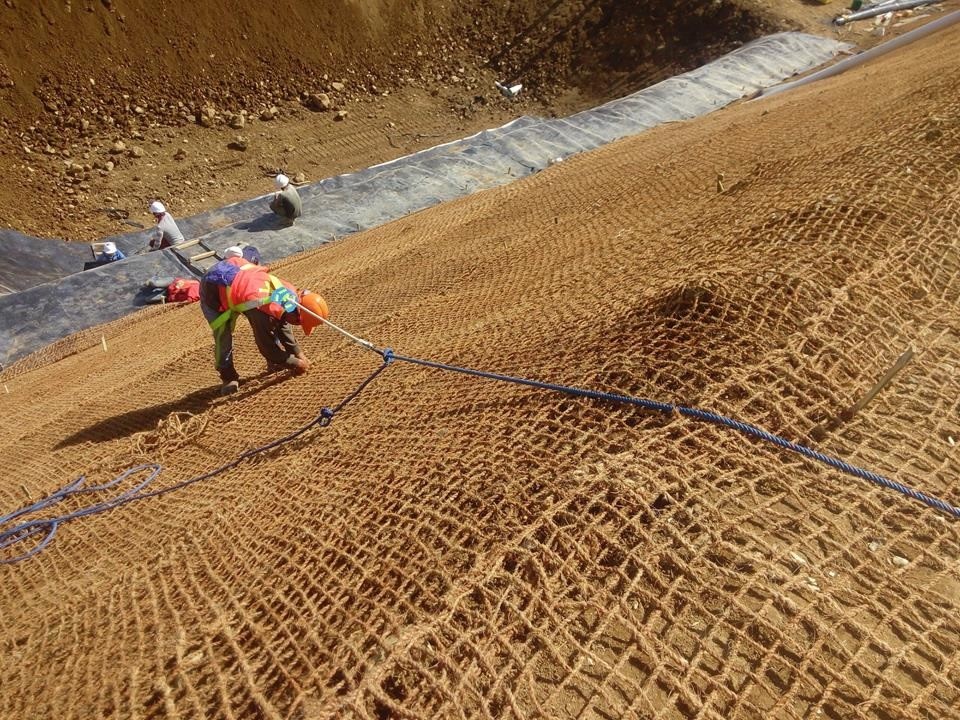Coir geotextiles uses – Coconut fiber is 100% biodegradable, organic and made from fiber. The consistency of coconut fiber is rough, strong and hard in nature. The constituents of coconut are mainly cellulose and lignin. Coconut fiber is resistant to natural elements, as well as to degradation by fungi and bacteria. Essentially, this means that the rate of degradation of coconut is much lower than that of any other natural fiber. This stability is explained by the high percentage of lignin in its composition.
Coconut fiber can now be found in the form of woven mesh mats as well as non-woven blankets stitched together. They are used in engineering in various geotechnical applications such as polymer applications in civil engineering. They have a long lifespan and do not harm the environment. Geotextiles, which have been gaining popularity in the recent past, have been in the industry for over 50 years and have already proven their worth and value both in the various industries they are used in and in our environment. While geosynthetics have long dominated the market, geotextiles have outperformed geosynthetics, which can harm the environment in the long run.
Coconut geotextile has proven to be effective in preventing landslides or soil erosion, prevents soil from shifting, and prevents erosion of nutrients that can cause plants to grow, all due to coconut geotextile’s high ability to absorb water and become able to turn into humus. In 3 years, the coconut fruit will be decomposed by the soil and the plants that live in it, because the material comes from the plants.
Discover the Function of Coir Geotextile
Coconut geotextile is a mesh made from coconut husks that helps in the recovery of mines, beaches or forests. Coconut geotextile serves as a growing medium, very suitable for recovering old mines or beaches, reinforcing rocks, preventing erosion, reinforcing soils, reinforcing tracks along railways, reinforcing rocks for roads or bridges. Its strong biodegradable nature helps facilitate the growth of new plants in coconut fields located in ancient lands.
Features of Geo Textile fabrics:
- It has the ability to divide, filter, strengthen, protect and drain when used in combination with soils.
- It drains areas where water collects, keeping the soil in place.
- It serves as an effective filter, retaining some materials and preventing drains from clogging.
- Reinforces earthworks such as gutters, keeping layers in place.
- Protects against erosion in places like roads and beaches.
What are the benefits of using geotextiles?
- Lightweight – They are light but very strong. This simplifies their processing and placement on the site. That means you’ll save on shipping and labor costs in the long run.
- Exceptional Tensile Strength – Mesh geotextiles have incredible strength and additional strength can be applied in the weave direction.
- They have proven to be one of the most effective 100% ecological methods of soil erosion control and slope stabilization.
- They do not leave harmful residues, are organic and 100% biodegradable.
- They promote optimal drainage and water retention.
- They can promote the growth of fertile vegetation.
Coir geotextiles uses to reforest ex-mining areas or bare forests. Many ex-mining greening consulting companies have started to switch to natural materials. The nature of the coir geotextiles material made from coconut fiber, which is able to store water for a long time, causes the soil surface covered by this material to maintain moisture. This is able to affect the structure of the soil so that it is easy to plant with seeds or seeds, besides that it is also coir geotextiles as a substitute for soil when planting seeds or plant seeds.
The advantage of this coir geotextiles material is that it is durable, according to this source, it can last about 4 years or more so the material can grow during the period of new vegetation growth. The use of coir geotextiles material is very suitable for sloping or rocky land, judging from the elastic properties. Examples that have been applied are in ex-mining areas.
